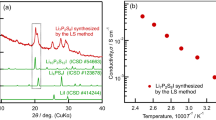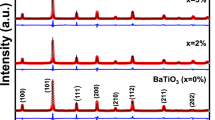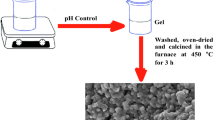Abstract
Present paper reports on the synthesis and electrical properties of Ni2+:Zn2SiO4 (Zn2−xSiO4 = xNi2+, x = 0.0, 0.25, 0.50 and 0.75 mol%) ceramic powders by a conventional sol–gel method. The structural details of Ni2+:Zn2SiO4 ceramic powders have been investigated from the measurement of XRD, FT-IR, Raman spectral profiles and SEM images. The results reveal that these ceramic powders are all in nanometer sized-grains of spherical forms with willemite structures. The XRD and EDAX results have thus corroborated the successful doping of Ni2+ ions into the Zn2SiO4 matrix. The dielectric real (ε′), imaginary (ε″) parts, loss tangent (tan δ) and AC conductivity (σac) properties as the function of frequency have been carried out and those are strongly dependent on Ni concentration and this behaviours have been explained on the basis of Maxwell–Wagner type of interfacial space charge polarization. Complex impedance analysis data shows only one semicircle corresponding to the grain boundary volume and thus suggesting that the conduction occurrence through grain boundary volume in Ni2+ doped samples and it has been explained using the Cole–Cole expression.
Graphical Abstract

.












Similar content being viewed by others
References
MPeko JC, Spavieri DL Jr, Da Silva CL, Fortulan CA, de Souza DPF, De Souza MF (2003) Solid State Ion 156:59–69
Canbay CA, Aydogdu A (2009) Turk J Sci Tech 4:121–216
Batoo KM, Kumar S, Lee CG, Alimuddin (2009) Curr Appl Phys 9:826–832
Sunu SS, Prabhu E, Jayraman V, Gnanasekar KI, Seshagiri TS, Ganasekaran T (2004) Sens Actutators B 101:161–174
Miki T, Ogawa T, Isobe T (2004) J Sol–Gel Sci Technol 31:73–77
Zhang HX, Kam CH, Zhou Y, Han XQ, Buddhudu S, Lam YL, Chan CY (2000) Thin Solid Films 370:50–53
Verma A, Goel TC, Mendiratta RG, Alam MI (1999) Mater Sci Eng B 60:156–162
Gandhi Y, Krishna Mohan N, Veeraiah N (2011) J Non-Cryst Solids 357:1193–1202
Li T, Qiu H, Ping W (2007) Thin Solid Films 515:3905–3909
Wu B, Qiu J, Peng M, Ren J, Jiang X, Zhu C (2007) Mater Res Bull 42:762–768
Elkestawy MA (2010) J Alloys Compd 492:616–620
Saafan SA, Assar ST (2012) J Magn Magn Mater 324:2989–3001
Mazen SA, Mansour SF, Dhahri E, Zaki HM, Elmosalami TA (2009) J Alloys Compd 470:294–300
Sakka S, Kozuka H (1999) Hand book of sol–gel Science and technology processing, characterization and applications vol 1. Sol–gel processing. Kluwer Academic Publishers, New York
Suryanarayana C, Grant Norton M (1998) X-ray diffraction: a practical approach. Plenum Press, New York
Cullity BD (1978) Elements of X-rays diffraction, 2nd edn. Wesley, Philippines
Elahi A, Ahmad M, Ali M, Rana MU (2013) Ceram Int 39:983–990
Nasir S, Anis-ur-Rehman M, Malik MA (2011) Phys Scr 83:025602–025607
Goswami M, Deshpande SK, Kumar R, Kothiyal GP (2010) J Phys Chem Solids 71:739–744
Chandra Babu B, Naresh V, Prakash BJ, Buddhudu S (2011) Ferr Lett Sec 38:114–127
Li C, Bando Y, Dierre B, Sekiguchi T, Huang Y, Lin J, Golberg D (2010) Nanoscale Res Lett 5:773–780
Naryan R, Tirupati RB, Das Bk, Jain GC (1983) J Mater Sci 18:1583
Patra A, Baker Gary A, Baker Sheila N (2004) Opt Mater 27:15–20
Lin CC, Shen P (1994) J Non-Cryst Solids 171:281–289
LewisIan R, EdwardsHowell GM (2011) Hand book of Raman spectroscopy from the research laboratory to the process line. CRC Press Taylor and Francis Group, New York
Wagner K (1913) Ann Phys 40:817
Maxwell JC (1973) Electricity and magnetism. Oxford University Press, Oxford 1:328
Shaik MA, Bellard SS, Chougule BK (1996) J Magn Magn Mater 152:391
Kilic C, Zunger A (2002) Phys Rev Lett 88:095501–095504
Rezlescu N, Rezelescu E (1974) Phys Status Solidi A 23:575–582
Kumar M, Yadav KL (2007) J Phys chem Solid 68:1791–1795
Azam A, Ahmed AS, Ansari, Muhamed Shafeeq M, Naqvi AH (2010) J Alloys Compd 506:237–242
Zaki HM (2005) Phys B 363:232–244
Batoo KM (2011) J Phys Chem Solids 72:1400–1407
Groothues H, Kremer F, Schouten PG, Warman JM (1995) Adv Mater 7:283–286
Inada H (1997) J Mater Sci 32:1867–1872
Kotnala RK, Gupta R, Shah J, Abdullah Dar M (2012) J Sol–Gel Sci Technol. doi:10.1007/s10971-012-2841-4
Doh SG, Kim EB, Lee BH, Oh JH (2004) J Magn Magn Mater 2238:272–276
Kumar NS, Narayaasamy A, Shinoda K, Chinnasamy CN, Jeyadevan B, Greneche JM (2007) J Appl Phys 102:013916
Acknowledgments
One of us (B.C.B) would like to thank the UGC, New Delhi for the award of a Rajiv Gandhi National Fellowship (RGNF) to him to carry out the present study.
Author information
Authors and Affiliations
Corresponding author
Rights and permissions
About this article
Cite this article
Chandra Babu, B., Buddhudu, S. Analysis of structural and electrical properties of Ni2+:Zn2SiO4 ceramic powders by sol–gel method. J Sol-Gel Sci Technol 70, 405–415 (2014). https://doi.org/10.1007/s10971-014-3296-6
Received:
Accepted:
Published:
Issue Date:
DOI: https://doi.org/10.1007/s10971-014-3296-6




